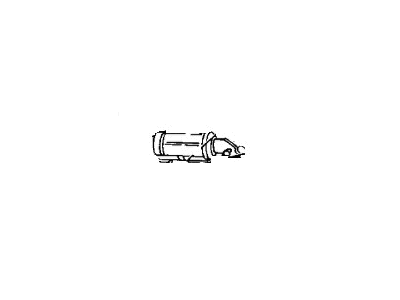
My Garage
My Account
Cart
Genuine Chrysler Imperial Wheel Cylinder
Brake Wheel Cylinder- Select Vehicle by Model
- Select Vehicle by VIN
Select Vehicle by Model
orMake
Model
Year
Select Vehicle by VIN
For the most accurate results, select vehicle by your VIN (Vehicle Identification Number).
1 Wheel Cylinder found
Chrysler Imperial WHEELCYLINDER-Wheel
Part Number: V2103246AA$16.69 MSRP: $21.24You Save: $4.55 (22%)
Chrysler Imperial Wheel Cylinder
The wheel cylinder in Chrysler imperial is part and parcel of hydraulic drum brake system having the responsibility of pressing the brake shoes against the brake drum for maximum stopping. Hydraulically operated and when this pressure is applied, two pistons pop out and force the brake shoes against the brake drum. Subsequently, the Chrysler Imperial models have incorporated both cast iron as well as aluminum wheel cylinders with the contemporary models avoiding rust by selection of aluminum. Eventually the Wheel Cylinder may run amuck and develop leaks or corrosion which will affect he motion brake mechanism. When it happens, replacement is preferred, however, they can be reconstructed if the costs of replacement are high. The design variations include dual single-piston cylinders which have this same function. This is right because, routine examination or Wheel Cylinder or timely replacement is vital in enhancing the capacity of the braking system of Chrysler Imperial cars.
Looking for affordable and high-quality auto parts? Then you have already arrived at the proper online shop. We offer all Chrysler Imperial Wheel Cylinder at great affordable prices. Moreover, all genuine Chrysler Imperial Wheel Cylinder come with a manufacturer's warranty. In the long run, you would realize you have saved a lot of trouble and money with OEM parts from here.
Chrysler Imperial Wheel Cylinder Parts Questions & Experts Answers
- Q: How to rebuild a wheel cylinder on Chrysler Imperial?A:Before deciding to rebuild a wheel cylinder, make sure parts are available. It's sometimes more practical to simply replace the old wheel cylinder with a new or rebuilt unit instead of rebuilding it. Raise the rear of the vehicle and support it securely on jackstands, then block the front wheels. Remove the rear wheels. Remove the rear hub/drum and the brake shoes. Disconnect the Brake Line (tube) from the back of the wheel cylinder and plug it. Unbolt the wheel cylinder and remove it from the backing plate. Clean the backing plate and wheel cylinder mating surfaces. Remove the bleeder screw and check to make sure it is not obstructed. Carefully pry the boots from the wheel cylinder and remove them. Push in on one piston and force out the opposite piston, cups and spring with the cup expanders from the bore. Clean the wheel cylinder, pistons and spring with clean brake fluid, denatured alcohol or brake system cleaner and dry them with compressed air. Check the cylinder bore and pistons for score marks and corrosion (pitting). Slight imperfections in the bore can be removed with fine crocus cloth (use a circular motion). Black stains on the cylinder walls are caused by the cups and will not impair brake operation. If the pistons or wheel cylinder bore are badly scored or pitted, replace the wheel cylinder. Lubricate the components with clean brake fluid or brake assembly lubricant prior to installation. With the cylinder bore coated with clean brake fluid or brake assembly lube, install the spring and cup expanders. Install the cups in each end of the cylinder. Make sure the open ends of the cups are facing each other. Engage the boot on the piston and slide the assembly into the bore. Carefully press the boot over the cylinder end until it is seated. Repeat the procedure for the remaining boot and piston. Install the bleeder screw. Apply ATV-type sealant to the wheel cylinder mating surface of the backing plate. To install the wheel cylinder, hold it in position, install the mounting bolts and tighten them. Unplug the brake line, insert it into the wheel cylinder fitting and carefully thread the flare nut into place. Once the nut is properly started, tighten it securely with a wrench. Install the brake shoes and the hub/drum. Bleed the brakes. Install the wheels and lower the vehicle. Check the brake operation very carefully before placing the vehicle into normal service.




